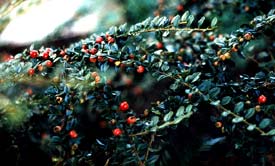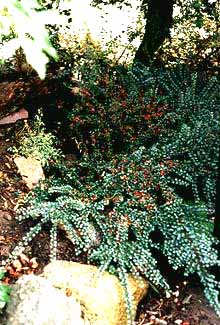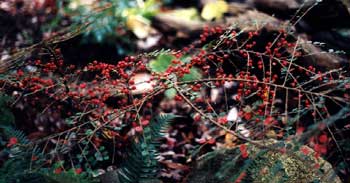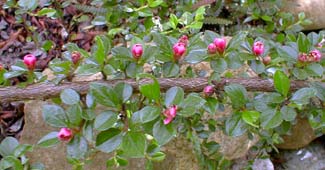 | |
| This September portrait shows this semi-prostrate shrub with its berries about half ripe. By October the berries have turned bright red, & during Novemember so do the leaves. Then in winter the deciduous leaves fall from the shrub leaving the berries on the bare branches clear through to spring. The shrub is shown leafless in late autumn in the third photo below. | |
Rockspray Cotoneaster
Our big beautifully fountaining Franchet's Cotoneasters are quite a contrast to the average sorry-ass Cotoneaster horizontalis or Horizontal Rockspray. The former is a tall elegant evergreen shrub, the latter a semi-prostrate deciduous groundcover capable of becoming completely scraggly.
When we bought the house, the southern yard's slope had a lot of neglected rockspray, a hardy plant but it was getting no sun whatsoever thanks to thick overgrowth, & was not getting its share of water either. In consequence the branches got long, thinly leafed, & homely. I suspect some of the rocksprays had been complete cut back a few times which did them no good; the root systems were enormous & went everywhere, but the shrubs themselves only popped up here & there in messy attitudes.
 When I set out to build up the slope into a cliff wall, extending thereby the flat area for gardens, a lot of the Rockspray had to be pulled up & tossed. I did save a few of the stringy things that were growing from between the old, lower rock wall. Those were nothing special, but not much else would grow out of the rocks down below, so they deserved some respect for survivor tendencies, & were welcome to their cracks.
When I set out to build up the slope into a cliff wall, extending thereby the flat area for gardens, a lot of the Rockspray had to be pulled up & tossed. I did save a few of the stringy things that were growing from between the old, lower rock wall. Those were nothing special, but not much else would grow out of the rocks down below, so they deserved some respect for survivor tendencies, & were welcome to their cracks. One specimen, however, growing near the top of the slope, was attractively fanned, so I made an attempt to save it. In building up the cliff wall & extending the flat portion of the upper gardens to the cliff edge, it meant that I had to bury the lower part of even that one good-looking specimen. Its lower trunk ended up a foot under the soil, for it could not be lifted up without chopping off its wide-ranging roots.
Much of the buried length of its sideways "trunk" developed new roots. This stuff is obviously hard to kill, & even such a halfhearted attempt to keep one of the rocksprays alive worked just dandy.
Rereading my slanders above, of this native of Western China, I almost feel I should start over, admitting I do quite like the specimen I kept. It has remained a praiseworthy little shrub now that it is being cared for.
At its best, fanning rockspray has many charms. In May it develops tiny pink-red buds which open white. The fourth photo below shows the bright pink May buds. The flowers develop by autumn into bright red berries sprinkled along the herring-bone pattern of the fans. The deciduous leaves turn a striking bright red late in autumn, & the bright berries last throughout Winter, finally falling away in early spring just as tiny green leaves are re-emerging.
 So on the rare occasion when rockspray really is at its best, it is one of the nicest of all semi-prostrate shrubs. Yet I see it planted in many peoples' yards, & it almost always looks neglected, only rarely tolerably good looking.
So on the rare occasion when rockspray really is at its best, it is one of the nicest of all semi-prostrate shrubs. Yet I see it planted in many peoples' yards, & it almost always looks neglected, only rarely tolerably good looking.If it is not often seen growing to best advantage, it may be because it has been too often treated as a plant that will get by in poor soil, burning direct sun, hardly ever watered, hence is occasionally spotted suffering on edges of parking lots or private driveways where it will survive, sure, but in a most unhappy state. Or it is planted too near sidewalks where the owners butcher it to shreds as it attempts to go about it's usual business of reaching its fans across rocks or concrete.
It actually requires partial shade to be at its greenest, wants rich well-drained soil like most other woody shrubs, & will never respond well to having its limbs shortened by sad attempts to limit its spread.
 Although it won't drop dead in drought conditions once it gets itself established, it won't develop very nicely without occasional deep watering either. Well, anyway, such are the excuses I make for it not always looking as nice as is possible when it is treated well.
Although it won't drop dead in drought conditions once it gets itself established, it won't develop very nicely without occasional deep watering either. Well, anyway, such are the excuses I make for it not always looking as nice as is possible when it is treated well.In our yard in early & mid Autumn, the birds do not like cotoneaster berries & do not touch the berries on either the Franchet's or the Horizontal Rockspray or on the Hawthorn trees. But in Winter when other pickings are scantier, or because the berries are not so horrible tasting after they've sweetened a little through a couple frosts, that's when larger birds eat them.
We have a birdbath, bird feeder, & many protective shrubs in the area of the cotoneasters, so this is bird paradise which we can observe from the living-room window with or without the opera-glasses, with a fieldguide to Pacific Northwest birds at hand. I've watched birds pluck a single cotoneaster fruit, carry it to the birdbath, & drop it in the water. Quite a lot of the berries accumulate in the water after a while, & I thought it was just because the birds decided it wasn't such a tasty berry & they wanted a drink of water instead. But someone else suggested the birds were actually trying to soak the tartness out of them, or soften them up to eat later. I don't know if that makes sense or not, but whatever the reason for it, it is an interesting behavior to observe.
We've other little cotoneasters, including C. dammeri bearberry, C. microphyllus little-leaf cotoneaster, & the hybrid dwarf "Tom Thumb" cotoneaster.
For more about Horizontal Cotoneaster, see:
Cotoneaster horizontalis,
in the autumn leaves gallery
and see
Cotoneaster horizontalis,
in the winter berries gallery